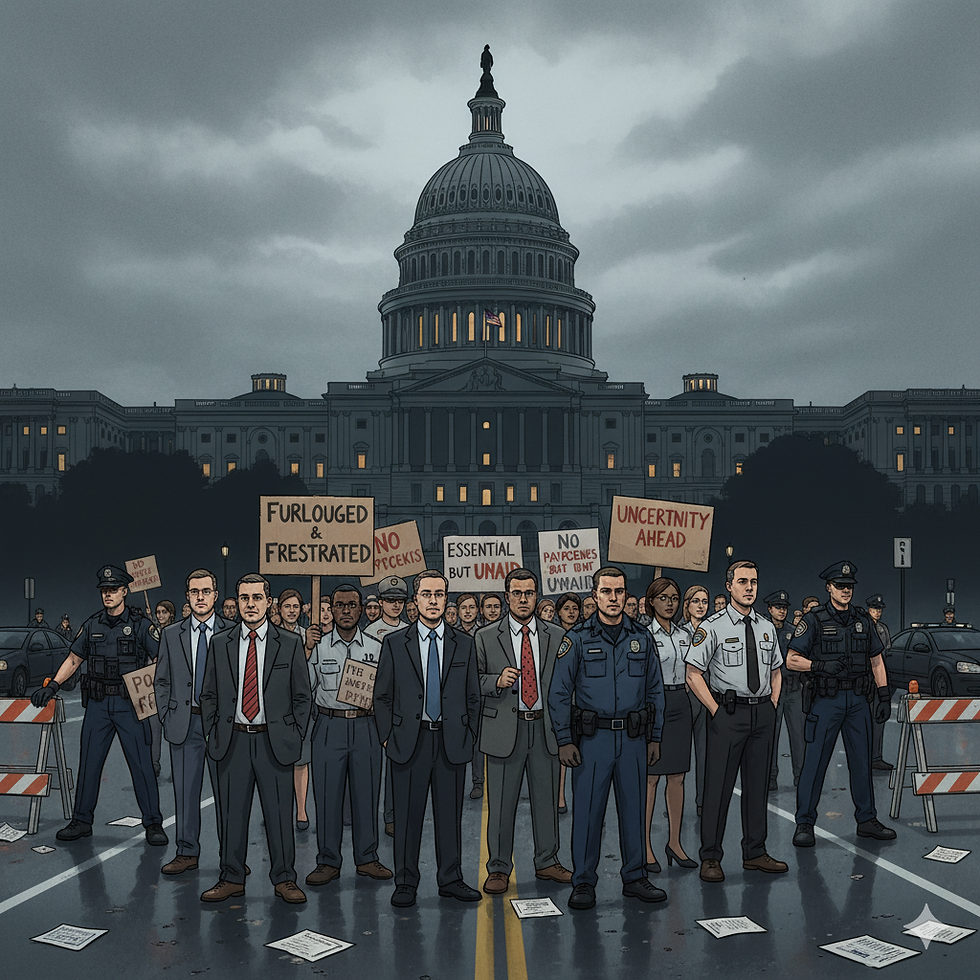The US government shuts down with possible mass layoffs on the horizon
- Directors' Institute

- Oct 1
- 4 min read
Amid the heightened polarisation, another component to the political precarity in the US leaves the masses awe-stricken and the government functioning on the margins. The Democratic ‘for-the-people’ agenda meets a flat wall: a stir-up occurs when the Trump-led Republican government fails to adhere to the healthcare and spending demands of its political counterpart. This resulted from the expiry of the government funding.
The action has led to several government operations being out of function, whereas some barely so: non-essential employees being furloughed, while essential ones being expected to continue working without any pay.

What has led to the shutdown?
The deep political divide between the left and the right being evident in every aspect is the most obvious in what the parties perceive basic rights to the citizens. Thus, while the Democrats view medical care and facilities as the basic right, the Republicans have long contested its economically disadvantageous nature for the country and hence have long stood the opinion that the affordability of healthcare facilities not only waters them down but also impacts its research and development, a facet the country so swears by. What has led to this situation was that the Democrats demand an extension of the Affordable Care Act subsidies, to which the Right responded stating that such policy-related issues require a separate consideration.
Where the Right-Wing party has an upper hand on both chambers of Congress, it managed to clock only 55 and felt short of 5 votes for 60, rendering itself unable to pass a spending bill. This is where the Democrats held on to their strategic advantage, as compliance with its political rival would lead to an increase in the costs of the healthcare facilities in the country. The conditions they put forwards are (i) an extension of tax credits for health insurance, which is due to expire and which makes health insurance more affordable; (ii) the undoing of cuts to medicaids by Trump administration; (iii) and the undoing/stoppage of spending cuts to the National Institutes of Health (NIH) and the Centres for Disease Control (CDC).
Impact on Employees as the US Government Shuts Down
Essential v. non-essential employees
When the US government shuts down, the workforce faces immediate disruptions. Essential employees, including those in the US military, police and other defence services are expected to continue their relentless services with no stated payday. Public health service providers, mediators and administrators; those contributing to the research and development of essential technological as well as non-technological aspects, namely drugs, food, agriculture etc. have been categorised as essential employees; among many others. Interestingly, even ICE (Immigration and Customs Enforcement) employees not only fall in this category but are also expected to continue their crackdown on illegal immigrants with full rigour.
Probability of Pay
The Federal and state government bodies in the US have been pretty promissory on their fiduciary duties: interim payments have been duly made to inflicted employees, including the furloughed ones. Hence, both essential and non-essential employees have been paid their full ‘fair’ dues retroactively. Note: here, ‘fair’ means the payment amount agreed upon on their respective service contracts and employment terms and thus does not include compensations, interest rates, late payment fees, liabilities incurred due to delays etc.
Possible Layoffs
The White House Office of Managment and Budget (OMB) has warned against some possible permanent discontinuation of services and has also issued some contingency plans as a measure anticipating this. An estimated 150,000 employees are expected to drop off the federal payrolls, higher than ever in the past 80 years. Discounting any permanent loss of jobs, an estimate 750,000 heads will be put on suspension due to economic conditions with a total daily cost of approximately $400 million in lost compensation.
Preferences in Employee Retention
Given the strictly right-leaning nature of the Republican Party, it is no surprise that the biggest portion of the layoffs is going to be left-supporting employees. This is not just a speculation but an open statement made by President Donal Trump himself: "We'll be laying off a lot of people," he said to reporters. "They're going to be Democrats."
Impact on the economy
The two factors that impact an economy during such a shutdown are both latitudinal and longitudinal, i.e. in terms of the time and its wide-ranging nature. Looking at the pattern, it can be stated that past shutdowns have been temporary with most activities resuming and at times recovered within months after they have ended. This time, however, a clear-cut estimate is that roughly 0.1 to 0.2% points could be at loss for every week spent in the shutdown, which can also be recouped. This is also somehow reinforced by the stock market owing to its reluctance to comment on the matter. The statement by the President himself on the cessation of services of several employees in itself is warning about a continued economic disruption for a prolonged period, albeit not a significant one.
Conclusion
The shutdown of the US government, more than a threat, is a measure to weed out unwanted portion of workforce, particularly one that poses a significant challenge to the incumbency and future prospect of the current government. It is a well-calculated step to uphold the national interest rooted in the idea of capitalism. With this, the Trump administration also aims to safeguard its interest of healthcare viability over its affordability.
Our Directors’ Institute - World Council of Directors can help you accelerate your board journey by training you on your roles and responsibilities to be carried out efficiently, helping you make a significant contribution to the board and raise corporate governance standards within the organization.




.png)






Comments